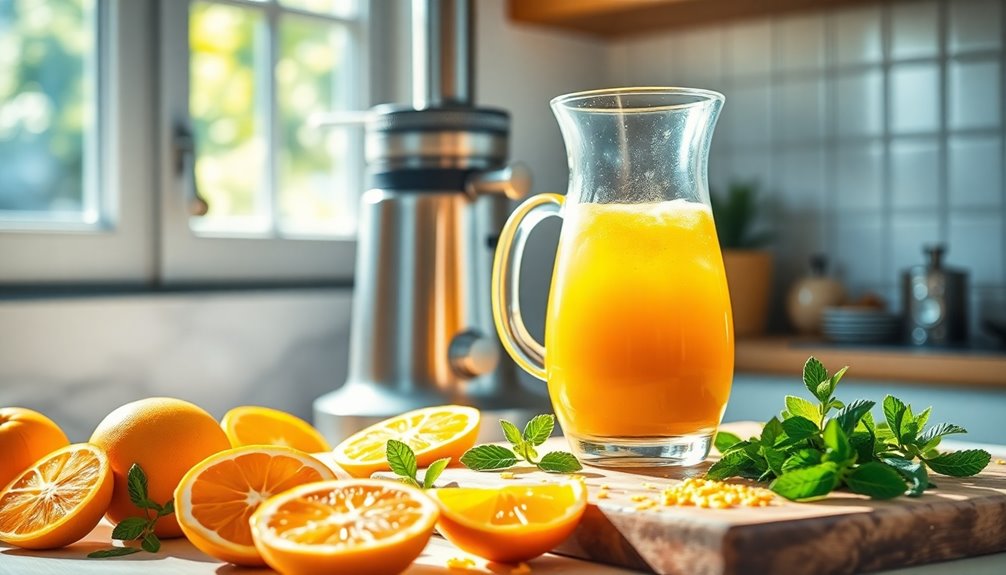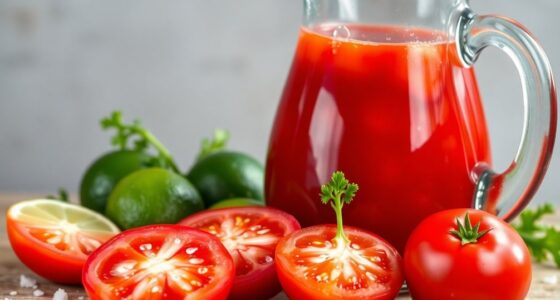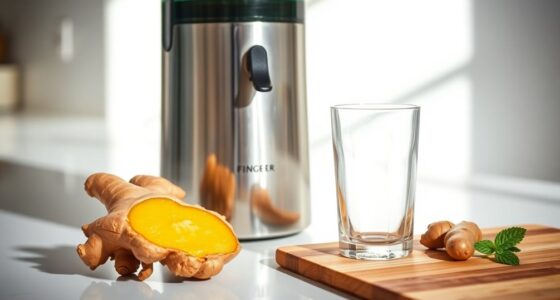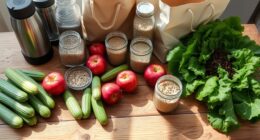To make concentrate juice, start by juicing fresh, ripe fruits like grapefruits or oranges. Freeze the juice in airtight containers for at least 24 hours. Once frozen, thaw the juice block in a strainer to separate the concentrated juice from the excess water. For a richer flavor, repeat the freezing and thawing process. Store your finished concentrate in an airtight container in the fridge for up to a week, and discover more ways to use it!
Key Takeaways
- Select fresh, ripe fruits like grapefruits or oranges for juicing to enhance flavor and quality.
- Juice the fruit thoroughly and freeze the liquid in airtight containers for at least 24 hours.
- Thaw the frozen juice block in a strainer to separate concentrated juice from excess water.
- Repeat the freezing and thawing process multiple times to intensify the flavor and color of the concentrate.
- Store the finished concentrate in an airtight container in the fridge for up to one week for various culinary uses.
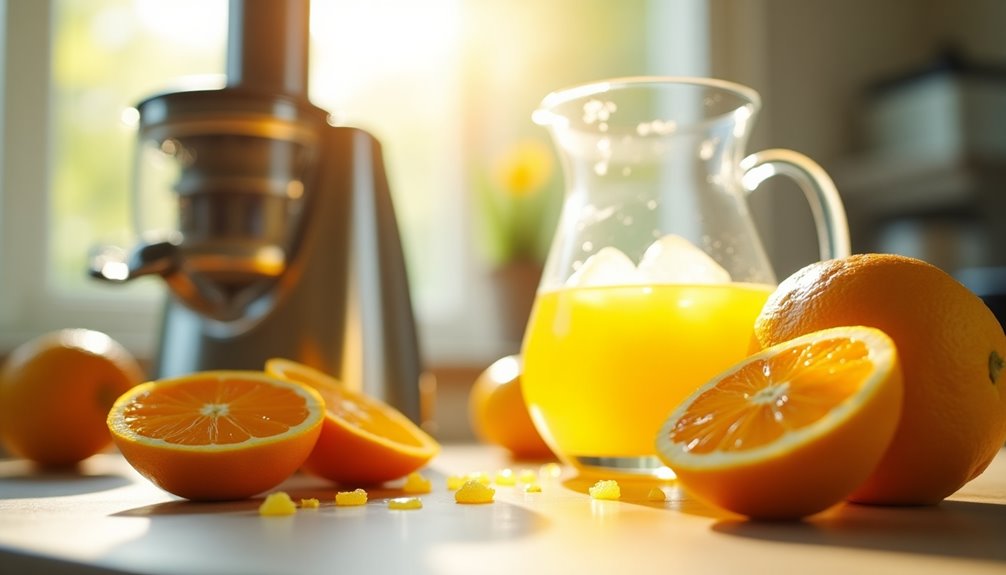
Making concentrate juice is a simple yet rewarding process that lets you enjoy vibrant flavors from your favorite fruits. If you're a fan of fresh juices, making your own concentrate can elevate your beverages and recipes to a whole new level.
To get started, choose the fruit you want to use—grapefruits, oranges, or any other juicy variety works well. Begin by juicing your chosen fruit, and then pour the fresh juice into airtight containers. It's essential to allow the juice to freeze for at least 24 hours, as this will transform it into a solid block of frozen juice.
After your juice has fully frozen, it's time to work on creating your concentrate. Remove the frozen block of juice from the container and place it in a strainer over a bowl. This setup is crucial, as it allows the juice in a strainer to separate from the ice as it melts. Allow the frozen juice to melt at room temperature; this process is where the magic happens.
As the block thaws, the water content begins to separate, leaving you with the concentrated juice that holds all those delicious flavors. Once the juice is completely melted, you'll notice a layer of clear ice resting on top. Carefully cut away this ice, as it contains mostly water and not much flavor.
What you want is the rich, concentrated juice collected in the bowl below. This juice is your concentrate fruit juice, and it's packed with flavor just waiting to be used in various recipes. If you're looking for an even richer taste, consider repeating the freezing and melting process a couple more times. Each additional cycle enhances the flavor and color, resulting in a more robust concentrate.
Now that you've got your concentrate ready, you'll want to store it properly. Transfer the finished concentrate into an airtight container, ensuring that it's sealed well to maintain its freshness. You can keep your concentrate in the fridge for up to one week, which means you'll have plenty of time to use it.
Whether you're adding it to smoothies, cocktails, or even desserts, this homemade concentrate can significantly enhance flavor and provide a delicious twist to your creations. Using concentrate juice allows you to control the sweetness and flavor intensity in your drinks and dishes.
You'll find that a little goes a long way, making it an economical choice as well. Plus, the satisfaction of creating your own juice concentrate adds a personal touch to your culinary adventures. So, roll up your sleeves and enjoy this hands-on approach to creating vibrant, flavorful juice concentrate that you can savor all week long!
Frequently Asked Questions
How Do I Make My Own Juice Concentrate?
To make your own juice concentrate, start by juicing your favorite fruits, like oranges or lemons.
Freeze the juice in a container for about 24 hours. If you're using harder fruits, boil them to extract the juice, then strain out the pulp.
Once frozen, let it thaw in a strainer to collect the liquid, discarding the ice.
Repeat this process to enhance the flavor, then store it in an airtight container in the fridge.
How Do They Make Concentrated Juice?
Imagine transforming a burst of fresh fruit into a syrupy delight! They make concentrated juice by removing water from freshly squeezed juice, keeping the essence intact. This process not only enhances the flavor but also makes it easier to transport and store. By understanding how juice is produced, we can appreciate the artistry behind each bottle, from the selection of ripe fruits to the careful extraction of their natural sweetness. Ultimately, concentrated juice provides a convenient way to enjoy the vibrant taste of fruit all year round. As the popularity of cocktails grows, many are finding innovative ways to mix flavors using concentrated juices. Learning how to create gin and juice opens up a world of possibilities, allowing enthusiasts to experiment with various combinations that highlight the unique characteristics of the fruits involved. With just the right balance, you can elevate your beverage experience, turning simple ingredients into refreshing drinks that tantalize the taste buds.
You've got several methods like vacuum concentration, which heats juice under low pressure, or freeze concentration, where they freeze the juice to separate ice crystals.
Lastly, they recover aromas to enhance the flavor, ensuring the concentrate tastes just as vibrant as the original juice.
How to Concentrate Liquid at Home?
To concentrate liquid at home, you can freeze it in an airtight container for 24 hours.
Once frozen, place the block in a strainer over a bowl at room temperature. As it melts, flavorful liquid will drip down while ice remains.
Carefully cut away the clear ice, ensuring the thawed liquid doesn't touch it.
Repeat this freezing and melting process two more times for a richer flavor.
Store your concentrate in the fridge for up to a week.
What Are the Ingredients in Juice Concentrate?
Imagine savoring the vibrant burst of flavor from your favorite fruit. In juice concentrate, you'll find just that, but in a more intense form.
Typically, the main ingredient is freshly squeezed juice, with its water content reduced. You'll also encounter natural sugars, acids, and nutrients, all essential for that rich taste.
Depending on the fruit, there may be additional components like preservatives, but many pure concentrates keep it simple, enhancing the fruit's essence.
Conclusion
Now that you know how to make concentrate juice, you can easily whip up your favorite flavors at home. Imagine hosting a summer barbecue, serving your homemade orange juice concentrate to guests. They'll be impressed by your skills and enjoy refreshing drinks made from fresh oranges. With a little practice, you can experiment with different fruits and create unique blends that cater to everyone's taste. So grab your ingredients and start juicing—great flavors await!
Cindy thoroughly researches juicing trends, techniques, and recipes to provide readers with practical advice and inspiration. Her writing style is accessible, engaging, and designed to make complex concepts easy to understand. Cindy’s dedication to promoting the advantages of juicing shines through her work, empowering readers to make positive changes in their lives through the simple act of juicing.

